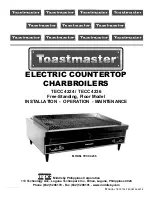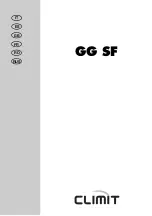
FEATURES & SPECIFICATIONS
HeatNet Control REV 1.38-1
Page 4
Introduction
The S
MITH
HeatNet Control
The Smith HeatNet boiler control is designed to provide the
Smith Water boilers with an integrated boiler management
system on every boiler. Steam Boiler control is not currently
available. The Smith HeatNet control provides for optimized
heating efficiency without the need for a “wall mount
control”. Since the Smith modular control method is based
on digital communications (Heat-Net), analog control
signals are not required. Although the use of analog control
signals is still supported (4-20mA control loops and 0-10vdc
(20mA minimum) control voltages), a higher level of
control precision, repeatability, and feedback is gained with
digital communications control.
With the HeatNet control, optimized heating efficiency is
accomplished by setting the Modulation Maximum (Mod-
Max) setting to exploit the inverse efficiency curve. This
value can be adjusted so that as each boiler is added, it
operates at its maximum turndown. This allows the
maximum number of boilers to operate at their lowest
inputs, until all boilers are firing. Once all boilers are firing,
full range modulation control is allowed. An outdoor reset
function is also provided to assist in the optimized heating
efficiency of the Smith boilers.
The Smith boiler with the HeatNet control, can be operated
in multiple ways:
A.
As a stand-alone boiler.
B.
A boiler in a Boiler Network using the HeatNet (H-
Net ™) protocol.
C.
A member boiler controlled by a boiler management
system with multiple input control methods.
The primary purpose of the control is to maintain the boiler
water temperature at the supply or the header sensor using a
target setpoint. While performing this task, the control also
monitors dedicated external limits in a limit string and
provides an orderly shutdown and fault indication in the
event of a tripped limit. The monitored limits include a
HIGH LIMIT AQUASTAT, LOW WATER CUTOFF, GAS
PRESSURE, FLOW, IGNITION CONTROL fault, GAS
VALVE alarm, VARIABLE FREQUENCY DRIVE alarm,
and other optional or user selectable limits.
The HIGH LIMIT circuit is independent of the
control and shuts down the ignition control and
the boiler if the control board or other
component of the boiler was to malfunction.
The control will continue to function and report
the fault, but its ability to control the boiler will
end.
Each Smith boiler employing this control can function as
either a master or a member. This allows one boiler (Master)
to be in control of target temperature. The other boilers
(Members) only respond to the commands issued by the
Master. If using an external control, all boilers can be setup
as members. The following will define the roles of master
and member.
Master
A boiler becomes a master when a temperature sensor is
connected to the J10 “SYS/DHW HEADER” terminals. The
sensor is auto-detected.
The master senses and controls the common system
header/loop water temperature using a system setpoint. It uses
any boilers it finds (over the H-Net communications cable) to
accomplish this. It can also monitor the Outside Air (OA)
temperature to provide outdoor reset functionality.
Only one
master is allowed in a system.
When operating as a master, the boiler provides a control
method using a PID algorithm to regulate water temperature.
This algorithm allows a single boiler (Master), or multiple
( Member) boilers.
Figure 1
Heat band
SETPOINT
UPPER HEAT
BAND LIMIT
LOWER HEAT
BAND LIMIT
Boilers Staged
ON
BOILERS
STAGED
OFF
Time
WATER
TEMPERATURE
The control algorithm is based upon a Heat Band, at the
center of which is the setpoint. While below the Heat Band,
boilers are staged on and modulated up until the Heat Band
is entered. Once in the Heat Band, modulation is used to
maintain setpoint. Boilers are shut down only when the top
of the Heat Band is breached. Timers are also used to
prevent short cycling.
While staging the boilers on, a modulation clamp
ADVANCED SETUP:MOD MAX – LAST FIRE
is used
to hold the boilers at a lower fire rate until the last boiler is
fired. Once the last boiler fires the modulation clamp is
removed and all boilers are allowed to fire above this
clamped percentage to 100%. This “boiler efficiency” clamp
is defaulted to 70% and thus limits all of the boilers
individual outputs to 70% until the last boiler fires. All
running boilers modulate up and down together, always at
the same modulation rate. As a general rule, this percentage
should be no lower than twice the minimum turndown to
minimize short cycling.
When additional boilers are needed to achieve setpoint in
the system, the Master boiler employs an ADAPTIVE
MODULATION algorithm to prevent over firing of the
system. The Master communicates over the H-Net to view





































